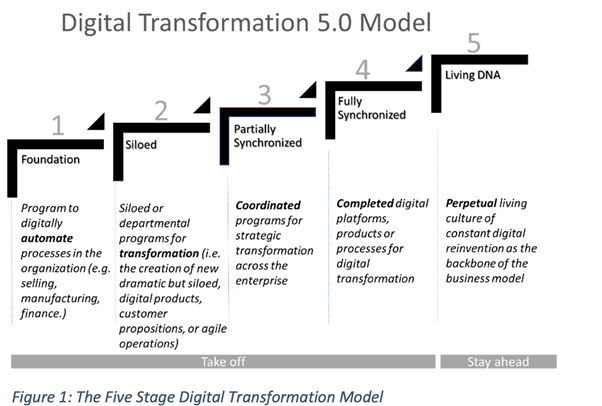How this Model Provides a Roadmap to Successful Transformation
We have talked in previous posts about the fact that Digital Transformation has a range of definitions. However, we can always be clearer on what the entire range looks like. Breaking up the range into different stages will help drive clarity on what level of digital transformation is being targeted. And of course, once your target is clear, your probability of success goes up significantly.
Let’s define that range. At a macro and societal level, Digital Transformation is the migration of successful organizations from the Third Industrial Revolution to the Fourth. The various stages within that range get you closer to the ultimate power of digital transformation. Is the ultimate stage of digital transformation the complete redesigning of processes, people and products to compete in the digital world? Yes, but a one-time upgrade of business model is insufficient. The only logical endpoint of successful digital transformations must be to reach a stage of perpetual market leadership via innovation. I call this a Stage-5 digital transformation.

Figure 1: The Five Stage Digital Transformation Model
Locking in the right definition of Digital Transformation also helps cut through the hype of technology vendors and consultants who tend to brand their offerings as “digital transformation”. The 5-stage Digital Transformation model in Figure 1 is an easy way to distinguish between in-process stages and the end-stage. I elaborate on each of the five stages next.
The 5-Stage Digital Transformation Model
Stage one is the Foundation. This is where enterprises are actively automating internal processes, such as selling, manufacturing or finance, using SAP, Oracle, Salesforce or similar platforms. This is more automation (also called digitalization), than transformation, but it provides the digitalized foundation necessary for future transformation. Automating processes using digital platforms is necessary to convert manual effort into data.
The next stage is called Siloed. You might see individual functions or businesses start to use disruptive technologies to create new business models. So, for instance the manufacturing function may have made progress on using the Internet of Things to drive major changes in the way they manufacture or manage logistics, or the finance manager may have heard about Blockchain and transformed the way they do intercompany accounting across countries. Alternatively, a business unit within the enterprise may have used technology to create a completely new business model, such as selling direct-to-consumer as opposed to going via retailers. The point is that these efforts are siloed and there is no overall company strategy driving transformation.
Stage three is Partially Synchronized transformation. The enterprise leader, owner or CEO has recognized the disruptive power of digital technologies and defined a digital future state. At Stage-3, the organization has started rowing in the same direction. However, the enterprise has not completed transforming to a digital backbone or new business models, nor has the agile, innovative culture become sustainable. A good example of this is GE’s digital transformation, which ultimately stalled at this stage. CEO Jeff Immelt defined his vision for a digital industrial future. The entire firm started to move towards a single digital strategy. However, the new digital business model never matured enough to develop strong roots.
Stage four or Fully Synchronized marks the point where an enterprise-wide digital platform or new business model has fully taken root. However, it is a one-time transformation. It is still just one technology (or business model) change away from being disrupted. The only way to survive continuous disruption threats is to make digital capabilities and an agile innovative culture an ongoing living DNA of the enterprise.
Stage five or Living DNA is the step where the transformation becomes perpetual. You maintain ongoing industry trend leadership because you are disciplined in constantly innovating and setting industry trends. You’re not just a market leader; you’re a disciplined innovator.
Summary
Understanding that digital transformation is a staged journey is key to realistic goal setting. It avoids the pitfall of equating a specific stage improvement on digital transformation with fool-proof, sustainable business leadership.
This is an excerpt by Tony Saldanha from his best-selling book, “Why Digital Transformations Fail.”



